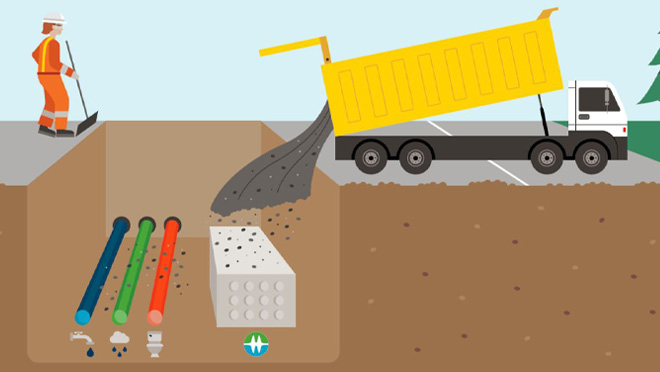BC Hydro and local government and collaborations
Find out how we've partnered with local governments to discover innovate ways to reduce costs, improve efficiency, and minimize community disruptions.
Explore our case studies below.
On this page:
- Case study: Using mapping tools to support shared capital planning
- Case study: Digging up the road once, in Surrey and beyond
- Case study: Lessons from missing-middle housing in Vancouver
If you'd like to know more, or have ideas for collaboration, reach out via localgov@bchydro.com.

A pilot workshop between local governments, us, and other utilities could point to a future of deeper collaboration and joint efforts on major capital infrastructure projects such as joint delivery of civil infrastructure. This approach would lead to reduced costs, shortened timelines—and potentially even happier residents.
The June 2024 capital planning workshop, in Langford, B.C. brought together BC Hydro, a dozen Southern Vancouver Island local governments, as well as Telus and FortisBC.
Our infrastructure investments
"We're investing in infrastructure projects across the Capital Regional District, including a pair of replacement transmission cables, and a new substation in the Langford area," said Maureen Daschuk, BC Hydro's Executive Vice-President.
Exploring new tools for collaboration
Workshop attendees spent a morning exploring our new geographic information system (GIS) digital mapping tool. "Our team used the software to pinpoint locations of our upcoming projects then 'layered on' additional infrastructure initiatives that other participants have in the works," Daschuk added.
Aligning timelines to reduce disruptions
The GIS tool highlighted opportunities to align timelines and, potentially, jointly deliver civil infrastructure. This would minimize community disruptions such as construction noise and road closures while lowering costs and speeding up project delivery.
Shifting from traditional models
This collaborative approach contrasts with the conventional model, where governments and utilities often share plans on a short-term basis and finalize project schedules independently, only to discover they're planning projects in the same area, one after another.
Learning and building relationships
The workshop served as an opportunity for participants to learn about one another's practices, preferences, and requirements on major infrastructure projects. It didn't fill in all the blanks, but it was a positive first step towards tighter linkages with local governments on future collaborations and partnerships. Participants built relationships, compared notes, and shared ideas.
Looking ahead: expanding to the Lower Mainland
In 2025, we hope to expand this approach to other local governments in the Lower Mainland.

As one of B.C.'s fastest growing communities, the City of Surrey is investing in infrastructure to support its booming population and economy. As part of an ongoing 10-year capital plan, the city is delivering $2.5 billion worth of municipal upgrades.
Our $1 billion commitment
We're supporting Surrey's growth with $1 billion in electrical infrastructure investments within the municipality's boundaries.
Upcoming upgrades in Surrey
"In the past five years alone, we've built and energized eight new underground distribution lines in the city, and there's much more to come," said Tammy Shore, a BC Hydro projects division manager.
"By the end of 2032, we expect we'll have built two new substations and expanded and redeveloped two existing ones, to reliably supply power for up to 157,500 new homes," added Neil Kelly, a BC Hydro project portfolio director.
Co-construction approach delivers a collaboration success
Three years ago, our infrastructure planning team learned that the City of Surrey aimed to rebuild a 1.2 kilometre stretch of 64 Avenue running east-west in the Cloverdale neighbourhood. As part of its project to add multi-use pathways, medians, and left-turn lanes, the City of Surrey planned to improve and update underground water and sewer lines.
"Since we were already planning to boost electrical capacity in the same area, we approached Surrey with a proposition: 'Since you'll already be digging up the road, could your crews install our needed conduit at the same time?'" said Tammy Shore.
Building trust while saving costs
We built a strong foundation of trust by working through this project, which came off without a hitch.
The "co-construction" approach helped both parties save money, with both our team and the City of Surrey reducing costs by about $500,000.
"We were able to shift our equipment onto other projects," said Shore. "And Surrey residents dealt with less inconvenience."
Expanding co-construction partnerships across the province
Since the 64th Avenue project, we've also recently completed a similar cost-sharing partnership with the Township of Langley. We're inviting all municipalities to bring forward potential projects.
Ideally, we'd embrace co-construction with communities across the province. We'll save our ratepayers' money, and local governments will be able to make better use of their tax dollars while reducing hassles for their constituents.

In the coming years, changes to provincial legislation will unlock many thousands of new small-scale multiple unit homes (SSMUH) in formerly single-family-only neighborhoods across B.C.
We know we'll have plenty of power to serve this new housing. Thanks to a recent collaboration with the City of Vancouver, we're now able to better serve its builders with new resources and a streamlined service-request process.
The City of Vancouver leading the way
The City of Vancouver is something of an SSMUH early-adopter and, as a result, has a head start on its municipal neighbours. In 2024 we received more than 350 service-connection requests from multiplex builders in the City of Vancouver—more than three times what we'd expected. So, when one of the city's staff members approached us looking to make things easier for their builder community, we were all over it.
Evolving to meet the building communities needs
Home builders in Vancouver and elsewhere have long used our Express Connections process to set up standard 200-amp service for their projects. For a traditional single-family detached house, requesting a new project connection is straightforward.
A builder looking to construct three, or even eight, new small homes on one formerly single-family lot will unsurprisingly need more power. That means following a different process for a design connection request and a larger, more expensive electrical service.
Streamlining complex connections
These more complex connections require more planning and logistics on our end. Since builders were less familiar with the process, navigating it was costing them time and money. After working with the City of Vancouver, we've not only developed new resources to clarify our requirements but also streamlined the connection request process behind the scenes. (For a summary of what we learned, visit our Small-scale, multi-unit housing guide for local governments.) We're also optimistic that we can continue working with local government partners to further improve the process so that the costs and timelines continue to become more predictable for builders.
Collaborating for a better future
"Ultimately, we share the same goal as Vancouver or, any of our local government partners: Bring the new SSMUH online as safely, quickly, and cost-effectively as possible. Thanks to Vancouver's outreach, we're ready to go to town," said Stefano D'Errico, BC Hydro's senior distribution design manager.